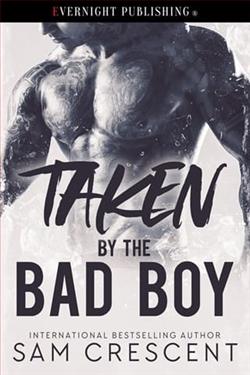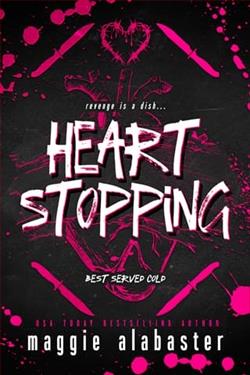Page 101 of The Way We Are
Regina shifts her eyes to mine. “Do you want in? Or do you want to call it a day?”
“I’ve got nothing to do until Savannah arrives. Let’s do this.”
Smiling, Regina flips on the police sirens to part the sea of traffic before replying to dispatch, “10-4, we’re two minutes out. Send back up.”
She beeps her horn at a dark sedan sitting in front of us. When it refuses to budge from its spot in front of a red light, she mounts the curb to skim down the side of him.
“Take down his tag. I’ll be sure to pay him a visit later.”
“Already on it,” I reply, jotting the offending motorist’s license plate onto my notepad.
I’ve only been on the job a few weeks, but I’ve already learned Regina’s traits well enough I can intuit her next move more times than not. By saying she's going to “pay him a visit later,” she means she's going to follow him across town until he inevitably makes a mistake, then she’ll ride his ass by giving him every ticket possible in the state of Florida.
With the road drenched by a recent downpour, it takes us a little longer to arrive on scene than Regina predicted. The crash site is unlike anything I’ve ever witnessed. A dark sedan is pinned between a concrete pillar meant to separate incoming and outgoing traffic and a white van, and the driver of the van is still seated in the driver’s seat, cradling a massive gash split across her forehead.
“10-41, we are on scene. What’s the ETA on emergency responders?” Regina asks into the radio at the same time a screamed, “Michael!” bellows through my ears.
Regina nudges her head to the trunk of our cruiser. “Get the first aid kit. Paramedics are still five minutes out.”
Confusion smacks into me when a dark-haired teenage boy races past me on my way to the trunk. Although I’m certain we’ve never met, there's something oddly familiar about him. I watch him sprint across the shards of glass littering the asphalt, not the least bit concerned for his safety. When he reaches the crumpled back passenger door of the sedan, the reasoning behind his frantic composure comes to light.
“Michael!” he screams on repeat as he claws at the crushed metal.
His attempts to open the door are thwarted. The sturdy steel used in old sedans like this barely budges when attacked with a saw, much less a teen’s hands.
Spotting a steel crowbar sitting next to the first aid kit, I grab it, slam down the trunk, then make my way onto the scene. When I notice Regina is aiding the driver out of the van, I slide the green first aid kit to her before moving to assist the teenage boy.
“Move to the side,” I command a man pacing back and forth at the side of the wreckage.
Bile surges to the base of my throat when a large cloud covers the low-hanging sun, allowing me to see the victim trapped inside the wreckage. It's a little boy who could be not much older than five.
My attempts to free the child become as frantic as the teenage boy. I ram the crowbar into the seam of the door before yanking on it with all my might. My frantic tugs on the steel bar pop some of the wrinkles the van caused to the door, but the metal barely budges.
Recalling months of training, I step back to assess the situation more thoroughly.
The sound of metal clinking on asphalt booms into my ears when I drop the crowbar onto the road so I can climb through the shattered driver’s side window. With the teen’s anguish at an all-time high, he failed to spot a suitable access point.
It's better this way, though. The scene inside the vehicle is ten times worse than it appears outside. The back passenger door has crumpled so far inward, the door has impacted over half of the safety seat the dark-haired boy is harnessed into.
“Hey, little guy,” I murmur, praying the lack of color in the boy’s cheeks is natural. “I’m just going... I’m just going to touch your neck. Okay?”
My hands rattle when I raise my fingers to his neck, praying to feel a pulse.
There isn’t one. Not even a faint one.
I hear, “No. No. No,” screamed from outside the vehicle as the dark-haired teen is dragged away from the car by another two boys so the fire department can access the vehicle without hinderance. The unnamed teen fights against his friends, but they hold him tightly, refusing to release him from their grasp.
While his friends sit with him, I stay with the little boy. I want to do more, but there's nothing more that can be done. His injuries are too extensive.
“We needan immediate blood workup on the driver of the sedan,” Regina instructs a set of paramedics in the process of sedating the man believed responsible for the accident. “He blew three times over the legal limit on arrival.”
I shift my eyes from the teenage boy sitting on the rain-soaked ground to the paramedic when she says, “This is an open and shut case. I can smell the booze on him.”
“Where are they taking him?” I ask, nudging my head to the ambulance I know is carrying the body of a little boy killed by his father’s stupidity.
Why anyone would get behind the wheel after drinking is beyond me. You’re not just risking your life when you drink and drive; you’re risking the innocent lives of those around you. Today’s accident proves that without a doubt.
Before the eerie similarities between my family situation and the little boy’s can mesh, the fair-haired paramedic answers my question. “With no formal identification on the driver or the casualty, we have no choice but to take them to Ravenshoe Public. The driver of the van is being transported to Mercer Private.”















